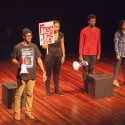“Breaking” barriers at Madison Dance Conference
The roots of break dancing trace to the streets of New York in the 1970s, but the dance style and corresponding hip-hop culture have since circulated throughout the world and found a beating heart in Madison when the UW Breakers formed in 2002.
Less than a decade later, the group continues to grow with a fever matched by its members’ passion for their shared form of personal expression.
Video: UW Breakers
Currently, the UW Breakers are rehearsing for the Madison Dance Conference from Nov. 19-21, the second annual gathering of UW–Madison student dance organizations to share their art with one another and the community. Events are set for the Memorial Union’s Great Hall and the Student Activities Center at 333 East Campus Mall.
The conference was founded in the fall of 2009 by Jeffrey Vinokur, now a junior biochemistry major, who is also the founder of Freestyle Funk Sessions, leader of the campus dance crew Rhythm Per Second, and known through Students Participating in Chemical Education as the “Dancing Mad Scientist.”
For the Madison Dance Conference, groups partner up to exchange moves for combined choreographed performances.
This year, UW Breakers is collaborating with the Trinity Irish Dancers. The two will perform with a dozen other organizations consisting of more than 120 dancers on Sunday, Nov. 21. Additionally, a number of groups are offering lessons to the public on Friday and Saturday, Nov. 19 and 20.
In preparation, the UW Breakers are finding where breaking and Irish dance have common ground.
“They teach us what they do, we teach them what we do, and we emphasize our similarities in our choreography,” says UW Breakers co-president Charlie Lee. “The movement and music becomes really unique.”
For Lee, a junior majoring in kinesiology, breaking “is part of my life, who I am and how I express myself.”
Lee is the son of Hmong immigrants who came to Wausau, Wis. in the 1980s. Lee explains that his family faced challenging culture clashes and had difficulty adapting. But Lee found himself an identity in American culture through the hip-hop movement.
With support from friends, he began breaking in high school and has carried his dedication to the culture through college.
For Lee and the UW Breakers, this culture is central to their purpose and mission.
“If you ask one of us if we break dance, we’ll say ‘yes,’ but for us it’s about so much more than the entertainment aspect of it,” he says, adding that he identifies as a “breaker” or “B-boy” rather than a “break dancer.”
The UW Breakers are often invited to host workshops for Madison public school students. At these events, Lee and the group turn off the music and talk with students in a “cipher” circle. They talk about future goals, and focus on educating the students about hip-hop culture and its meaning instead of breaking’s impressive physicality and ability to entertain.
“Breaking and hip-hop are very much about community, and supporting the youth. It is very much a youth movement. And real hip-hop is about bringing people together — a real live DJ, MC and breakers all coming together to share something meaningful to each of them,” Lee says.
In addition to the Madison Dance Conference, the UW Breakers are looking forward to participating in next spring’s Breaking the Law, the only international breaking competition in Wisconsin.
UW-Madison graduate Jarius King, who avidly contributed to the hip-hop culture on campus as a student, helped bring the event to Madison and will reunite with UW Breakers and additional participating groups at the competition in the spring.
Lee invites all students with an interest in breaking and hip-hop culture to check out their collaboration at the Madison Dance Conference, and get in touch with him and the UW Breakers to discover more and participate in their inclusive practices and events.
Tags: arts, student life, video


